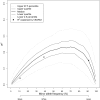Warfarin pharmacogenetics: a single VKORC1 polymorphism is predictive of dose across 3 racial groups
- PMID: 20203262
- PMCID: PMC2865873
- DOI: 10.1182/blood-2009-12-255992
Warfarin pharmacogenetics: a single VKORC1 polymorphism is predictive of dose across 3 racial groups
Abstract
Warfarin-dosing algorithms incorporating CYP2C9 and VKORC1 -1639G>A improve dose prediction compared with algorithms based solely on clinical and demographic factors. However, these algorithms better capture dose variability among whites than Asians or blacks. Herein, we evaluate whether other VKORC1 polymorphisms and haplotypes explain additional variation in warfarin dose beyond that explained by VKORC1 -1639G>A among Asians (n = 1103), blacks (n = 670), and whites (n = 3113). Participants were recruited from 11 countries as part of the International Warfarin Pharmacogenetics Consortium effort. Evaluation of the effects of individual VKORC1 single nucleotide polymorphisms (SNPs) and haplotypes on warfarin dose used both univariate and multi variable linear regression. VKORC1 -1639G>A and 1173C>T individually explained the greatest variance in dose in all 3 racial groups. Incorporation of additional VKORC1 SNPs or haplotypes did not further improve dose prediction. VKORC1 explained greater variability in dose among whites than blacks and Asians. Differences in the percentage of variance in dose explained by VKORC1 across race were largely accounted for by the frequency of the -1639A (or 1173T) allele. Thus, clinicians should recognize that, although at a population level, the contribution of VKORC1 toward dose requirements is higher in whites than in nonwhites; genotype predicts similar dose requirements across racial groups.
Figures


References
-
- Wadelius M, Pirmohamed M. Pharmacogenetics of warfarin: current status and future challenges. Pharmacogenomics J. 2007;7(2):99–111. - PubMed
-
- D'Andrea G, D'Ambrosio RL, Di Perna P, et al. A polymorphism in the VKORC1 gene is associated with an interindividual variability in the dose-anticoagulant effect of warfarin. Blood. 2005;105(2):645–649. - PubMed
-
- Sconce EA, Khan TI, Wynne HA, et al. The impact of CYP2C9 and VKORC1 genetic polymorphism and patient characteristics upon warfarin dose requirements: proposal for a new dosing regimen. Blood. 2005;106(7):2329–2333. - PubMed
-
- Veenstra DL, You JH, Rieder MJ, et al. Association of Vitamin K epoxide reductase complex 1 (VKORC1) variants with warfarin dose in a Hong Kong Chinese patient population. Pharmacogenet Genomics. 2005;15(10):687–691. - PubMed
-
- Carlquist JF, Horne BD, Muhlestein JB, et al. Genotypes of the cytochrome p450 isoform, CYP2C9, and the vitamin K epoxide reductase complex subunit 1 conjointly determine stable warfarin dose: a prospective study. J Thromb Thrombolysis. 2006;22(3):191–197. - PubMed
Publication types
MeSH terms
Substances
Grants and funding
- R24 GM061374/GM/NIGMS NIH HHS/United States
- U01 GM063340/GM/NIGMS NIH HHS/United States
- HL65962/HL/NHLBI NIH HHS/United States
- U01 GM074492/GM/NIGMS NIH HHS/United States
- U19 HL065962/HL/NHLBI NIH HHS/United States
- U01 HL065962/HL/NHLBI NIH HHS/United States
- GM63340/GM/NIGMS NIH HHS/United States
- NS053646/NS/NINDS NIH HHS/United States
- WT_/Wellcome Trust/United Kingdom
- K24 HL068834/HL/NHLBI NIH HHS/United States
- HL068834/HL/NHLBI NIH HHS/United States
- GM081488/GM/NIGMS NIH HHS/United States
- HHMI/Howard Hughes Medical Institute/United States
- HL066176/HL/NHLBI NIH HHS/United States
- HL71083/HL/NHLBI NIH HHS/United States
- GM61374/GM/NIGMS NIH HHS/United States
- R01 NS053646/NS/NINDS NIH HHS/United States
- U01 GM061374/GM/NIGMS NIH HHS/United States
- R01 HL074724/HL/NHLBI NIH HHS/United States
- HL092173/HL/NHLBI NIH HHS/United States
- K23 NS045598/NS/NINDS NIH HHS/United States
- R01 HL092173/HL/NHLBI NIH HHS/United States
- GM074492/GM/NIGMS NIH HHS/United States
- HL074724/HL/NHLBI NIH HHS/United States
- R01 GM081488/GM/NIGMS NIH HHS/United States
- NS45598/NS/NINDS NIH HHS/United States
- R01 HL066176/HL/NHLBI NIH HHS/United States
LinkOut - more resources
Full Text Sources
Other Literature Sources
Medical
Molecular Biology Databases

